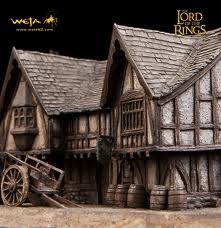The Tavern: Just a trope or something more?


Hello world! As the banner on the site will tell you, the wonderful ladies of Heroines of Fantasy have decided to add a male voice to the blog. I am humbled by the generosity of my sister authors from Hadley Rille Books. I hope I can add one or two bits and pieces to this experience. Thanks in advance for all who visit this site. All of us here on HoFare dedicated to the idea of ‘story’, and the MOST important element in that equation is the READER. Thanks for coming!
When I considered what I might do for my first post, I was neck-deep in edits for novel number two, and I realized I had a number of important scenes taking place in taverns and inns. I don’t feel too uneasy about that because two of my main characters are poets forced to make their way as entertainers of sorts. I see a role for the ale-house-wine-shop-village watering hole in my stories, but I am still forced to confront the questionable use of what many consider an over-used scenario.
In other words, what is the deal with all the inns and taverns in fantasy?
I have read quite a few blog posts and critical articles decrying the “trope”: those elements that get so overused that they become hackneyed and stale to the point of being crutches for bad writers to cling to when they need help with a story. Others have exhaustingly catalogued these tropes (just word itself suggests tired and misdirected), so I won’t add any more invective to the pile. I get it. Certain images and situations seem to get overused in fantasy more than in other genres. Why that happens is Today I want to talk about taverns or inns and make an apology of sorts for their frequent use in fantasy novels. I come by my affliction by inclination because I’ve been addicted to Middle Earth and all its incarnations since I first heard about Bilbo’s mad dash down the hill to meet the dwarves at the Green Dragon in Bywater. In fact, Tolkien probably did more to cement the idea of the tavern/inn as a staple of fantasy than anyone else. We could blame him for all the copy-cat crutch use since, or we could take another look at the role taverns have played and temper our judgement.
The simple truth is we love our taverns. We frequent them. We take ownership of them (rugby gangs, anyone?). We leave bits and pieces of ourselves in them (my initials are still legible on a brick in the inner wall of the Tav in Ellensburg, Washington). We name our chat rooms after them! I know this because I was the one back in the early days of theonering.net who won the contest to name the chatroom. “Barliman’s” seemed appropriate. I wish I had figured out how to use the snazzy email they gave as the prize. I was too much a hobbit to figure out how to incorporate Vetch@theonering.net into my non-techie email universe. The tavern is part of our cultural identity, so it stands to reason that it should enter our fiction as well. And it is when we ill-use the tavern in our fiction that we create the trope argument so pervasive in the genre criticism. They can’t just be set pieces placed to allow a writer to move characters around and create chaos and conflict. They work best when they serve their deeper purpose in the world the writer creates.
In Tolkien’s world, the tavern stood for civility in a wild world, a gathering place for locals and travelers to interact and share news of the road. They helped knit Tolkien’s pre-industrial, not-everyone-has-a-palantir environment together. For the professor, the inn helped define part of the human experience in middle earth. Anyone ever come across a Dwarfish tavern? An Elvish waystation? Nope. Taverns show up in Middle Earth in places where Men and their near cousins the Hobbits settled. Man built the roads in Middle Earth. Everybody else built really interesting things, kingdoms and enclaves and refuges and such, but Man is the one who knit all the various places together by a system of roads, villages and towns. There are wonderful hints of how widespread the Numenorean culture was throughout The Lord of the Rings. In fact, some of the earliest writings Tolkien put together were the tales and poems that take pace in the ‘cottage of lost play’…nice euphemism for a tavern from my so-very-temporary-human perspective. Let’s face it, Tolkien liked his pipes and his pints. The Inklings were vital to his creative genius, so it should come as no surprise that taverns in all their convivial glory appear in his writing where it dealt with the world of Man/Hobbits.
For JRRT, the tavern was a sign of elevated culture. Where are the references to ale-houses in Rohan? Laketown? I can’t find any (although Tolkien does give hints to trade—wine barrels down the river, etc, that is suggestive). All the references seem to point to the Shire, Bree, Tharbad, and Minas Tirith. Settled places. Places where people collected for pints and news. Places where trade occurs.
Do we give the professor a pass on his use of the trope? I think we should because he avoids the kinds of mistakes that so many others make. I point to several instances where his use of the tavern serves an important moment in LOTR. Sam’s early interaction at the Green Dragon prefigures the reality of the Ents and also illustrates his romantic, sensitive nature that will bear such wonderful fruit later on in the story. The other, of course, is how he uses The Prancing Pony at Bree. In his letters and other writings, he tells us the story stalled at Bree. Maybe intuitively he knew he was at a contrived place. What leads me to give him the pass here is how well he developed Barliman and his inn as an integral plot element of the story. In fact, nearly everything that happens later in the tale hinges on the way things unfold at The Prancing Pony.
I’m not talking about Frodo and the ring or Aragorn in the shadows or Nazgul blades in the night.
I’m talking about an undelivered letter. Butterbur’s establishment was so much more than a place for events to happen. Tolkien lovingly establishes its local and regional importance. Barliman was the unofficial postmaster for the district, and if he had managed to get that note to Frodo in time, the Fellowship would have been a far different and less exciting story.
And this is where I feel the most strongly about how we use our ‘places’ in our stories. Great events transpire in Tolkien’s Bree: violence, terror, character, intrigue. These sorts of things appear over and over again in other novels incorporating the tavern, and we get the accusations of ‘tropeness’ when THAT’S ALL THAT HAPPENS.
Bree is actually where the hobbits' growth begins in earnest. It is the place at the end of the novel where we, and they, see the results of that growth. It knits together the tale like it knits together the culture within which Tolkien makes it exist. It is not just a plot device designed to introduce Strider. It is a reminder of what happens when communication goes awry.
Frankly, I like taverns. I like using them in my own writing because the world my characters inhabit need them for poetry duels, assignations and rest.
I am sure my defense of the tavern/inn has holes. I’d like to read what all of you think about taverns and various other ‘places’ that seem to pop up time and time again in fantasy.
Mark Nelson
Published on September 09, 2012 12:14
No comments have been added yet.



